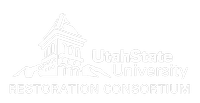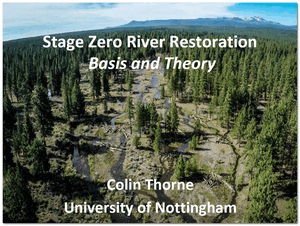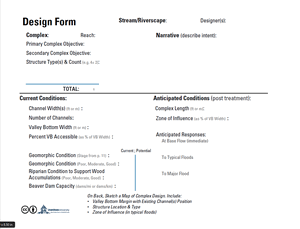Introduction to Stage 0 Restoration
October 22-24, 2019 Black Butte Ranch, Sisters, Oregon River Restoration North West & Portland State University Sponsored
Day 1
Stage 0: Genesis & Theory
Colin Thorne got us started with an introduction to Stage Zero River Restoration: Basis & Theory.
Western Streams: Evidence for Stage 0 & Using Stream Evolution Model to guide restoration approaches
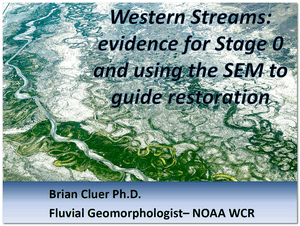 Next, Brian Cluer showed us some of the evidence for Stage 0 in riverscapes throughout the west.
Next, Brian Cluer showed us some of the evidence for Stage 0 in riverscapes throughout the west.
Stage Zero Valley Types
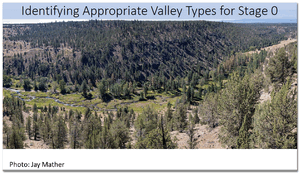 Paul Powers walked us through some ways of reading valley settings and riverscapes where Stage 0 may be appropriate.
Paul Powers walked us through some ways of reading valley settings and riverscapes where Stage 0 may be appropriate.
Intorduction to Low-Tech Process-Based Restoration to Stage 0
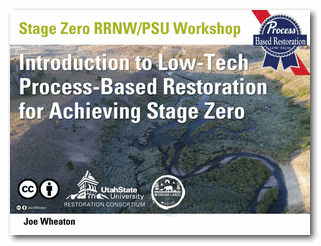 Joe Wheaton gave us an overview of Low-Tech Process-Based Restoration and how it is used to achieve Stage 0.
Joe Wheaton gave us an overview of Low-Tech Process-Based Restoration and how it is used to achieve Stage 0.
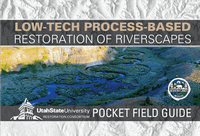 This talk is elaborated in Chapter 1 & Chapter 2 of design manual. We also handed out a Pocket Guide.
This talk is elaborated in Chapter 1 & Chapter 2 of design manual. We also handed out a Pocket Guide.
AFTERNOON: Wychus - Camp Polk Field Visit & Low-Tech Construction Intro
Day 2 - Field Trip to South Fork McKenzie River
 We started out with a presentation from Kate Meyer on Stage 0 Restoration in the South Fork McKenzie River, before trekking out into the wonderful mess.
We started out with a presentation from Kate Meyer on Stage 0 Restoration in the South Fork McKenzie River, before trekking out into the wonderful mess.
Example of Vision
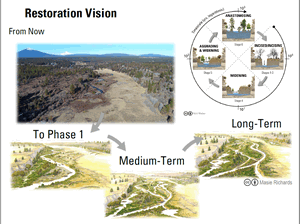 An example from Wychus Creek to elaborate on concepts covered in design talk and show examples of:
An example from Wychus Creek to elaborate on concepts covered in design talk and show examples of:
- Vision for Phased Implementation
- Simple Indicators for Monitoring
- Concept of Overlapping Complex Zones of Influence
https://s3-us-west-2.amazonaws.com/etalweb.joewheaton.org/Workshops/Stage0/2019/Slides/2019_PSU_Wheaton_LTPBR_Whychus.pdf
https://s3-us-west-2.amazonaws.com/etalweb.joewheaton.org/Workshops/Stage0/2019/Slides/Design+Exercise+with+Staley+Creek%2C+Class+Exercise+2.pdf
https://s3-us-west-2.amazonaws.com/etalweb.joewheaton.org/Workshops/Stage0/2019/Slides/Floodplain+Evaluation+Tools+-+June+4+2019.pdf
https://s3-us-west-2.amazonaws.com/etalweb.joewheaton.org/Workshops/Stage0/2019/Slides/Stage0GeomorphicAnalysisandExamples.pdf
https://s3-us-west-2.amazonaws.com/etalweb.joewheaton.org/Workshops/Stage0/2019/Slides/Thorne_Benefits+and+Risks+of+Restoration+to+Stage+Zero.pdf
https://s3-us-west-2.amazonaws.com/etalweb.joewheaton.org/Workshops/Stage0/2019/Slides/Thorne_Stage+0+Monitoring%2C+Permitting+and+Adaptive+Management.pdf
Day 3 - Building Low-Tech Restoration Structures
- Design Exercise - (Chapter 4 - Design Manual); Pocket Guide)
- Split into groups, discuss design objectives for their complex, layout project with flags Logistics, Safety & Post Pounding (Chapter 6 - Design Manual); Pocket Guide)
- Hands-on construction of various structures (PALS, Post-Assisted BDAs, Postless BDAs; Chapter 6 - Design Manual) - Design Manual; Pocket Guide)
- Review and critique constructed structures
- Discussions on adaptive management (Chapter 3, 4 & 6) - Design Manual)
- Workshop synthesis (review principles) & where to turn for help
Wychus Findings
Instruction Team
References
Stage Zero
- Cluer, B. and Thorne, C., 2013. A Stream Evolution Model Integrating Habitat and Ecosystem Benefits. River Research and Applications, 30(2): 135-154. DOI: 10.1002/rra.2631
In Support of Stage Zero
-
Walter, R.C. and Merritts, D.J., 2008. Natural streams and the legacy of water-powered mills. Science, 319(5861): 299-304
-
Hauer, F.R., Locke, H., Dreitz, V.J., Hebblewhite, M., Lowe, W.H., Muhlfeld, C.C., Nelson, C.R., Proctor, M.F. and Rood, S.B., 2016. Gravel-bed river floodplains are the ecological nexus of glaciated mountain landscapes. Science Advances, 2(6): e1600026. DOI: 10.1126/sciadv.1600026
Geomorphic Grade Line
- Powers, P.D., Helstab, M. and Niezgoda, S.L., 2018. A process-based approach to restoring depositional river valleys to Stage 0, an anastomosing channel network. River Research and Applications, 0(0). DOI: 10.1002/rra.3378
Other Supporting Restoration / Conservation Papers
-
Castro, J.M. and Thorne, C.R., 2019. The stream evolution triangle: Integrating geology, hydrology, and biology. River Research and Applications, 35(4): 315-326. DOI: 10.1002/rra.3421
-
Hiers, J.K., Jackson, S.T., Hobbs, R.J., Bernhardt, E.S. and Valentine, L.E., 2016. The Precision Problem in Conservation and Restoration. Trends Ecol Evol, 31(11): 820-830. DOI: 10.1016/j.tree.2016.08.001
-
Johnson, M.F., Thorne, C.R., Castro, J.M., Kondolf, G.M., Mazzacano, C.S., Rood, S.B. and Westbrook, C., 2019. Biomic river restoration: A new focus for river management. River Research and Applications. DOI: 10.1002/rra.3529
-
Sedell, J.R., 1984. Importance of streamside forests to large rivers: the isolation of the Willamette River, Oregon, U.S.A., from its floodplain by snagging and streamside forest removal. Verh. Internat. Verein. Limnol., 22: 1828-1834.
Stage 0 in UK
- Thorne, C.R., Hardwick, M., Winfield, P. and Oliver, C., Design of an environmentally aligned flood alleviation scheme: the Burn of Mosset, Moray, Scotland, Flood Risk, pp. 339-360. DOI: 10.1680/fr.41561.339
Low-Tech Process-Based Restoration
- Wheaton J.M., Bennett S.N., Bouwes, N., Maestas J.D. and Shahverdian S.M. (Editors). 2019. Low-Tech Process-Based Restoration of Riverscapes: Design Manual. Version 1.0. Utah State University Restoration Consortium. Logan, UT. 286 pp. DOI: 10.13140/RG.2.2.19590.63049/2.
Some Science in Support of Low-Tech PBR
- Silverman NL, Allred BW, Donnelly JP, Chapman TB, Maestas JD, Wheaton J, White J and Naugle DE. 2018. Low-tech riparian and wet meadow restoration increases vegetation productivity and resilience across semi-arid rangelands. Restoration Ecology. DOI: 10.1111/rec.12869.
- Weber N, Bouwes N, Pollock M, Volk C, Wheaton JM, Wathen G, and Jordan C. 2017. Alteration of stream temperature by natural and artificial beaver dams. PLOS ONE. 12(5): e0176313. DOI: 10.1371/journal.pone.0176313
- Wall E, Bouwes N, Wheaton JM, Bennett SN, Saunders WC, McHugh PA, and Jordan CE. 2016. Design and monitoring of woody structures and their benefits to juvenile steelhead trout (Oncorhynchus mykiss) using a net rate of energy intake model. Canadian Journal of Fisheries and Aquatic Sciences. DOI: 10.1139/cjfas-2016-0131.
- Bouwes N, Weber N, Jordan CE, Saunders WC, Tattam IA, Volk C, Wheaton JM and Pollock MM. 2016. Ecosystem experiment reveals benefits of natural and simulated beaver dams to a threatened population of steelhead (Oncorhynchus mykiss). Scientific Reports. 6: 28581. DOI: 10.1038/srep28581.
- Bouwes N, Bennett S and Wheaton JM. 2016. Adapting Adaptive Management for Testing the Effectiveness of Stream Restoration: An Intensively Monitored Watershed Example. Fisheries. 41: 2: pp. 84-91. DOI: 10.1080/03632415.2015.1127806
- Macfarlane WW‡ , Wheaton JM, Bouwes N, Jensen M, Hough-Snee N, and Shivick J. 2015. Modeling the capacity of riverscapes to support beaver dams. Geomorphology. DOI: 10.1016/j.geomorph.2015.11.019.
- Pollock, M., Beechie T , Wheaton JM, Jordan C, Bouwes N, Weber N, and Volk C. 2014. Using Beaver Dams to Restore Incised Stream Ecosystems. Bioscience. DOI: 10.1093/biosci/biu036.
- Wheaton J, Bennett S, Bouwes N, and Camp R. 2012. Asotin Creek Intensively Monitored Watershed: Restoration Plan for North Fork Asotin, South Fork Asotin and Charlie Creeks. Eco Logical Research, Inc., Prepared for Snake River Salmon Recovery Board. Logan, UT, 125 pp.
- Pollock M, Wheaton JM, Bouwes N and Jordan CE. 2012. Working with Beaver to Restore Salmon Habitat in the Bridge Creek Intensively Monitored Watershed: Design Rationale and Hypotheses. NOAA Technical Memorandum, NOAA Northwest Fisheries Science Center, Seattle, WA, 108 pp.

